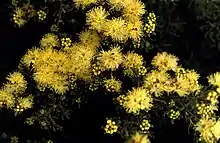| Melaleuca leiopyxis | |
|---|---|
 | |
| Scientific classification | |
| Kingdom: | Plantae |
| Clade: | Tracheophytes |
| Clade: | Angiosperms |
| Clade: | Eudicots |
| Clade: | Rosids |
| Order: | Myrtales |
| Family: | Myrtaceae |
| Genus: | Melaleuca |
| Species: | M. leiopyxis |
| Binomial name | |
| Melaleuca leiopyxis | |
| Synonyms[1] | |
|
Myrtoleucodendron leiopyxe (F.Muell. ex Benth.) Kuntze | |
Melaleuca leiopyxis is a shrub in the myrtle family, Myrtaceae and is endemic to an area near the west coast of Western Australia. It has bright yellow flowers and is very similar to Melaleuca depressa. The ranges of the two species overlap making it difficult to distinguish between them.
Description
Melaleuca leiopyxis is a low, dense, ground hugging shrub to about 50 cm (20 in) or sometimes a much more erect shrub to 3 m (10 ft). Its leaves are arranged alternately, have a thin covering of soft hairs and are narrow oval to elliptical in shape, with a blunt to slightly pointed tip.[2][3]
The flowers are arranged in heads up to 25 mm (1 in) in diameter at or near the ends of the branches, with 3 to 4 groups of flowers, 3 flowers in each group. The flowers mainly appear during September and October and are bright yellow, turning brown with age. The stamens are arranged in bundles of five around the flower, with 8 to 14 stamens in each bundle. The cup-shaped base of the flower, the hypanthium is 2–3 mm (0.08–0.1 in) long and covered with silky hairs. The fruit are woody capsules arranged in irregular groups, each capsule 4–7 mm (0.2–0.3 in) long, 5 mm (0.2 in) in diameter and cup-shaped.[2][3]
Taxonomy and naming
Melaleuca leiopyxis was first formally described in 1867 by George Bentham in Flora Australiensis.[4][5] The specific epithet (leiopyxis) is derived from Greek words meaning "smooth" or "bald", and "box", referring to the smooth fruit.[3]
Distribution and habitat
Melaleuca leiopyxis occurs in the Kalbarri - Shark Bay area[2] in the Carnarvon, Geraldton Sandplains and Yalgoo biogeographic regions.[6] It grows in red sand on sand dunes and limestone hills.[7]
Conservation status
Melaleuca leiopyxis is listed as "not threatened" by the Government of Western Australia Department of Parks and Wildlife.[6]
Use in horticulture
This melaleuca is rarely cultivated although it has grown successfully in Adelaide. It would probably be an excellent plant to trial in exposed coastal gardens.[2]
References
- 1 2 "Melaleuca leiopyxis". Plants of the World Online. Retrieved 31 August 2021.
- 1 2 3 4 Holliday, Ivan (2004). Melaleucas : a field and garden guide (2nd ed.). Frenchs Forest, N.S.W.: Reed New Holland Publishers. pp. 168–169. ISBN 1876334983.
- 1 2 3 Brophy, Joseph J.; Craven, Lyndley A.; Doran, John C. (2013). Melaleucas : their botany, essential oils and uses. Canberra: Australian Centre for International Agricultural Research. p. 222. ISBN 9781922137517.
- ↑ "Melaleuca leiopyxis". APNI. Retrieved 16 March 2015.
- ↑ Bentham, George (1866). Flora Australiansis. London: Lovell Reeve & Co. p. 160. Retrieved 16 October 2023.
- 1 2 "Melaleuca leiopyxis". FloraBase. Western Australian Government Department of Biodiversity, Conservation and Attractions.
- ↑ Paczkowska, Grazyna; Chapman, Alex R. (2000). The Western Australian flora : a descriptive catalogue. Perth: Wildflower Society of Western Australia. p. 395. ISBN 0646402439.